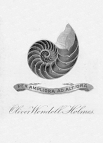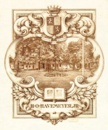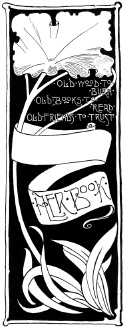
Bookplates have long been identified with bibliophiles (lovers of books, collectors of books). The earliest bookplates appeared in Germany a few years after the invention of movable type. Albrecht Dürer (German, 1471-1528) and Hans Holbein the Younger (German, 1497/8-1543) designed and engraved several bookplates. The earliest known American plate may be the one for Stephen Daye in 1642. Paul Revere (American, 1735-1818) was well known for his bookplate engravings, as was Nathaniel Hurd (American, 1730-1778). The practice of designing bookplates flourished throughout the 18th and 19th centuries.
The majority of bookplates found today are mass produced, most of them sold in bookstores. Highly personalized examples are still being produced for collectors by a number of graphic artists.
Examples:

German, Bookplate for Hilpbrand of Biberach,
1470-80, hand-colored woodcut.
Hilpbrand of Biberach was a Cistercian Monk whose very early
bookplate presents an angel
holding the coat of arms
of the Brandenburg Family.

India, Mughal
dynasty, Shamsa (Rosette) bearing the name and titles
of the Emperor Shah Jahan (reigned 1628-58), illuminated page, 17th century, ink,
colors, and
gold on paper, 15 3/16 x 10 7/16 inches (38.6
x 26.5 cm, Metropolitan Museum of Art, NY. A shamsa (literally,
sun) is a form of illuminated bookplate, that traditionally
opened imperial Mughal albums. Here, the center of the design is a calligraphic pattern intertwining the official imperial
name and titles of Shah Jahan. See rosette.

English, Bookplate for the Earl of Guilford, Wroxton Abbey,
18th century, engraving
on paper, 112 x 90 mm, U of Notre
Dame, South Bend, IN. This heraldic
design consists
of a shield supported by two dragons rampant, wings elevated,
ducally gorged and chained, with an earl's crown. The arms:
azure a lion passant or between three fleurs-de-lis argent. The
motto: "La vertu est la seule noblesse." This plate
most likely belonged to Francis, 1st Earl of Guilford (1704-1790),
Frederick, 2nd Earl (1732-1792), or George Augustus, 3rd Earl
(1757-1802).

American, Boston, Bookplate of Oliver Wendell Holmes, "Per
ampliora ad altiora", 1875, engraving on paper,
c. 10.3 x 7.4 cm, National Library of Medicine, Bethesda, MD.
This bookplate depicts
a chambered nautilus — a seashell with a volute
design.

Baron von Voelkersam (German) designer, Bookplate for Czar Nicholas
II, 1907, Library of the Winter Palace, St. Petersburg,
Russia. The focal point
of the arms of the czar
is an ancipital eagle.

J. Winfred Spencely (American, 1865-1908),
Bookplate
for H. O. Havemeyer, Jr., 1905, 101 x 82 mm, U of Notre
Dame, South Bend, IN. This design is comprised of a view of a
house set within an elaborate frame, with a shield, motto and
a crown above, and an
open book below. The arms:
quarterly, 1 - sable a lion rampant to the sinister argent, 2
and 3 - gules, 4 - sable a lion rampant argent. The motto is
"Virtute et industriae."

Katharine Newbury (American, 1878-1973), Bookplate for a Woman, c. 1904, ink on paper, Michael Delahunt collection. Drawn in the style of Art Nouveau, the design bears this text: ". OLD WOOD TO BURN . OLD BOOKS TO READ . OLD FRIENDS TO TRUST ." A space has been left on the ribbon at the center of the design for the name of the owner of the book: "
![]() - Her Book." Having graduated from the School of the Art Institute of Chicago in 1902, Katharine Newbury pursued a career as a graphic designer. She produced many letterheads and monograms, and illustrated at least one book, a cookbook. She also designed household objects, including a pair of wrought iron firedogs; and she painted a number of pictures in watercolor. Newbury married George Manierre III in 1906. They had five children. Virtually all of her extant artworks predate that year. One of her children — Samuel Manierre (1908-1988) — became an art historian and teller of tales, and one of her grandchildren authors the Web site you are looking at. See feminism and feminist art.
- Her Book." Having graduated from the School of the Art Institute of Chicago in 1902, Katharine Newbury pursued a career as a graphic designer. She produced many letterheads and monograms, and illustrated at least one book, a cookbook. She also designed household objects, including a pair of wrought iron firedogs; and she painted a number of pictures in watercolor. Newbury married George Manierre III in 1906. They had five children. Virtually all of her extant artworks predate that year. One of her children — Samuel Manierre (1908-1988) — became an art historian and teller of tales, and one of her grandchildren authors the Web site you are looking at. See feminism and feminist art.

![]()

![]() Here is how you can print Katharine Newbury's bookplate on adhesive paper for your own use: Insert "full sheet labels" into your computer's printer. Avery brand labels, product #8165 for ink jet printers, can be purchased either from a local office supply store or online. On each 8 1/2 x 11 inch white sheet you will print eight 2 x 5 inch bookplates. Make your prints in one or both of these sets of colors: in reds, blues, and browns or in greens, pink, and violets. These are "PDF" files that you can open with the free Acrobat Reader (version 4 or later).
Here is how you can print Katharine Newbury's bookplate on adhesive paper for your own use: Insert "full sheet labels" into your computer's printer. Avery brand labels, product #8165 for ink jet printers, can be purchased either from a local office supply store or online. On each 8 1/2 x 11 inch white sheet you will print eight 2 x 5 inch bookplates. Make your prints in one or both of these sets of colors: in reds, blues, and browns or in greens, pink, and violets. These are "PDF" files that you can open with the free Acrobat Reader (version 4 or later).

Eric Gill (English, 1882-1940), Bookplate for Ananda Coomaraswamy: Girl with
Deer, 1920, relief
print on paper, 60 x 60 mm,
Tate Gallery, London.

Eric Gill, Bookplate for S. Anthony, 1926, intaglio
print on paper, 121 x 86 mm, Tate Gallery, London.

Philip Hagreen (English, 1890-1988), Bookplate
for Eric Gill [monogram], no date, relief
print on paper, 37 x 45 mm.
An open book with a monogram
on each page. On the left page is a cross with CSP at its base.
On the right page is an E above a G.

John Farleigh (English, 1900-1965), Bookplate for William Maxwell, 1933,
wood engraving, 94 x
72 mm, U of Notre Dame, South Bend, IN. An owl sits on the handle
of a printing press, an eagle is above, a well displays the text "Maccus
Well" at its center, and a pile of books lie below, against
a background of bookshelves
and distant landscape.

Bookplate for Louis Berger, c. 1935-40,
etching
on paper, 105 x 145 mm, Phillipe
Masson Ex Libris Collection, McGill U, Montreal, Canada.

Rockwell Kent (American, 1882-1971), Bookplate
of John Whiting Friel and Helen Otillie Friel, 1953,
photolithograph, 8 1/2 x 6 1/b inches. Kent produced this design in four
sizes, and this is the
largest. A cleric's eyes wander as he reads at the foot of a
tree which is bearing trees among its leaves.

Orren Kickliter (American, 1964-), My Bookplate, c. 2000, wood
engraving on paper, 3 x 2 inches,
the artist. Mr. Kickliter has said that much of the content
of his work comes from various ancient and modern philosophies,
and that his style has been influenced
by his enthusiasms for early European printing and German Expressionism.
See American Colonial art, ephemera, German art, and Northern Renaissance.
https://inform.quest/_art
Copyright © 1996-![]()